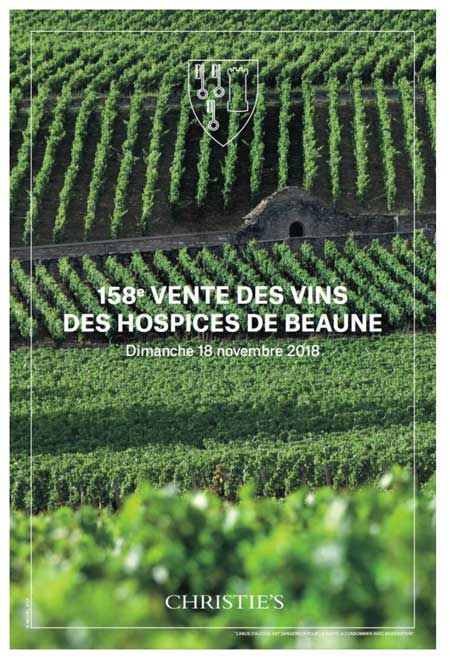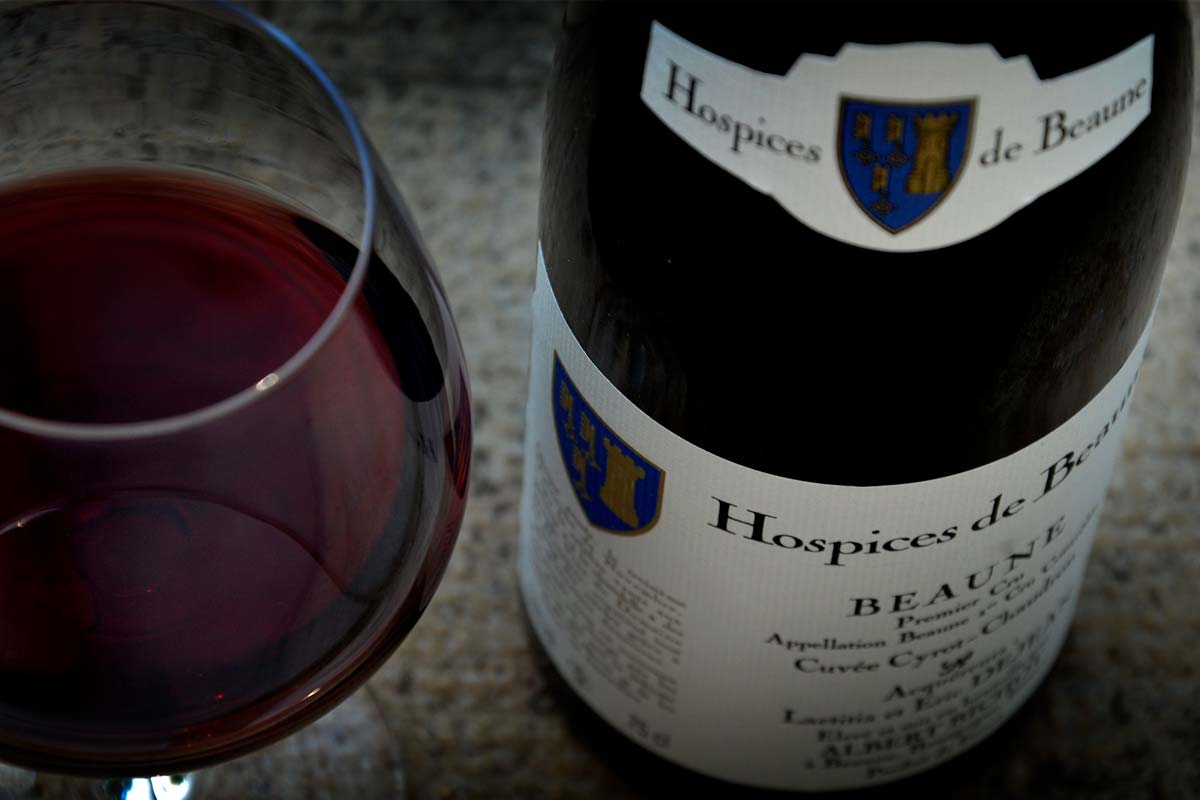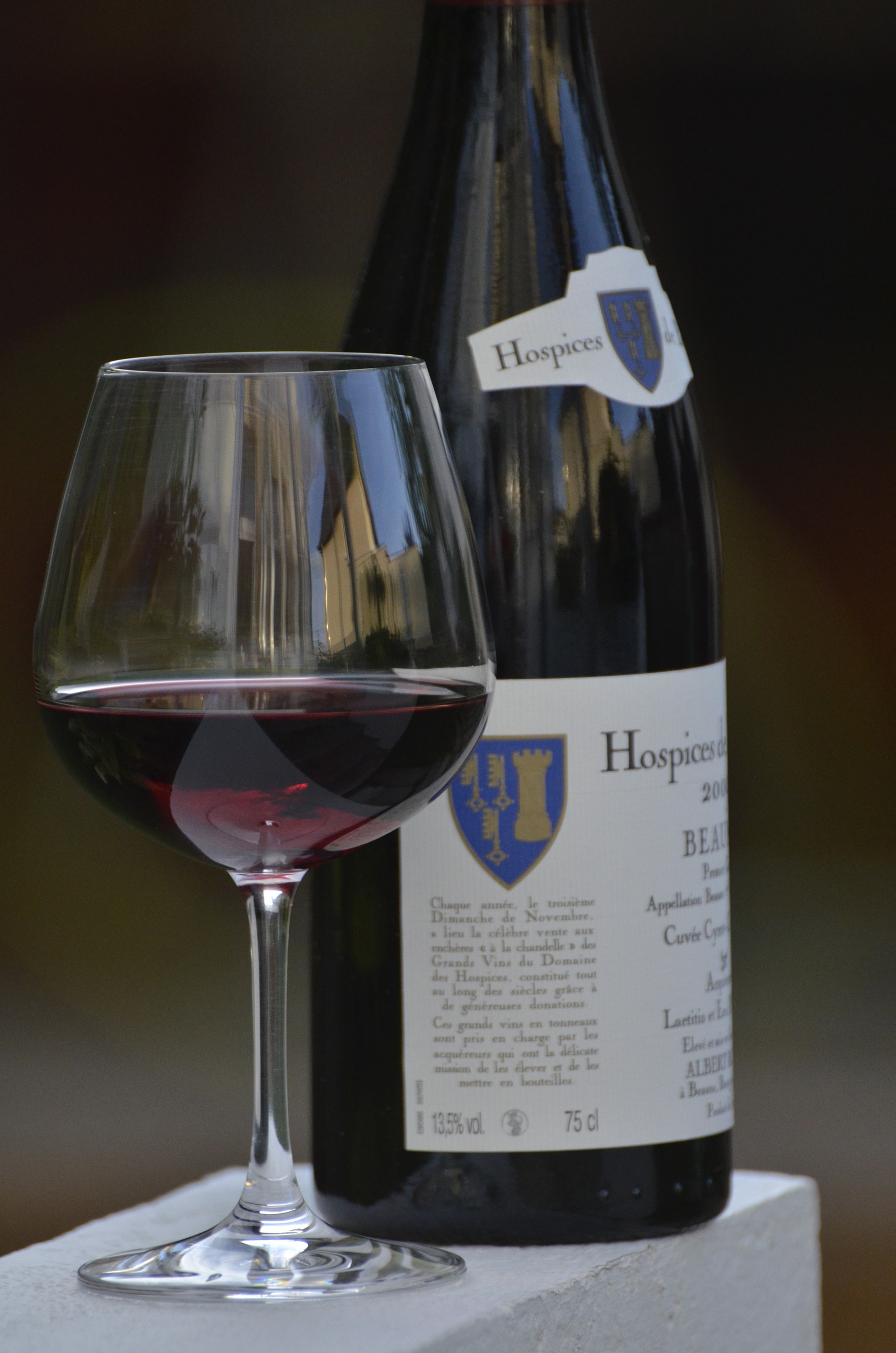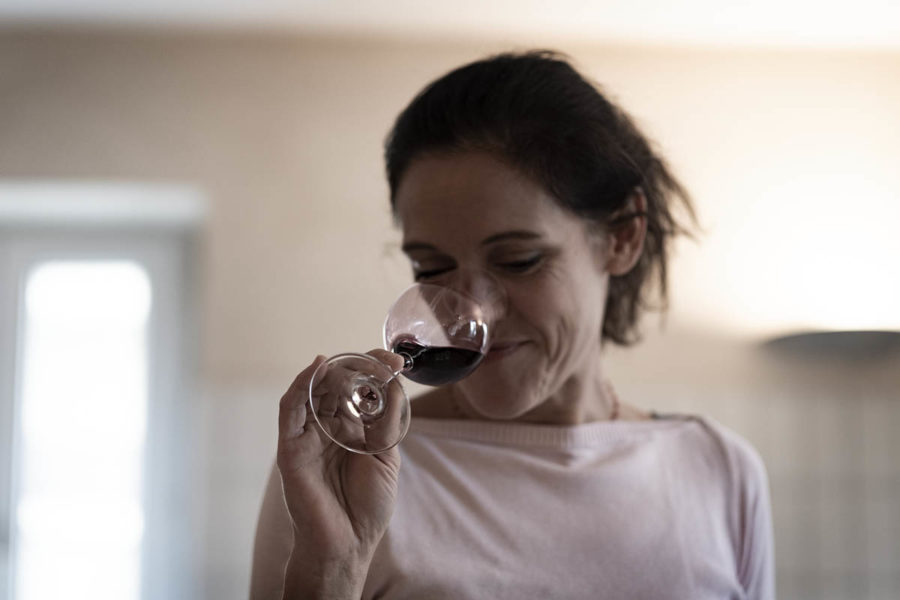Hospices de Beaune estate vintage 2018: generous and balanced according to Albert Bichot

WHITES WINES
White wines from the Hospices 2018 vintage are frank, true to their appellation and terroir hierarchy, rich and balanced. They show some important structure, even though they rare not yet at their highest expression level. Typical 2018 character is about power more than shining minerality so far, but wines are always a great expression of their terroir. Appellation levels are well respected, a good explanation of the climats de Bourgogne hierarchy.
Pouilly, Saint-Romain and Beaune are in a pleasure-driven spectrum of density and aromas. Meursault is still stamped by the vintage warmth but great terroirs are here and will reveal themselves without a doubt thanks to a good and necessary control of yields operated by Ludivine in the vineyards.
A very promising greatness already signs the famous top level whites from the hill of Corton or the notorious
Bâtard-Montrachet with splendid potential and ageing capacity for all of them.
RED WINES
Red wines from the Hospices 2018 vintage are globally with great density, amplitude and generosity. Keywords would be : high tannic levels in a good envelope, ripeness of fruits but with a fortunate good freshness toothanks to good acidity levels. This acidity, combined with firm structure and elegant yet firm tannins gives us wines that can be enjoyed in their primeon some sectors (Auxey, Monthélie, Pernand), whilst some other more prestigious terroirs bring an extra ageing potential.
Auxey-Duresses and Pernand wines have a good body, with rather soft tannins and a ripe fruit. They’ll be enjoyed on the youth of their fruit and a beautiful, pleasing texture. Pommard wines are easier to enjoy and less austere than some other years. Ample structure and body with fine complexity and moderate tannins. Beaune wines display some heterogeneity (due to so many plots on this village) but globally all wines are true to theirroots and where they come from, with some very good surprises. Corton wines are beautiful, with some elegance on a quite present and solid backbone. Nice energy (hint of limestone minerality), ripe fruit and relief in a freshness zone. Reminds us of the great 2015 vintage. Côte de Nuits impresses us with superb density and depth. Rich wines with a great ageing potential. Not to miss.
Domaine des Hospices de Beaune 2018 vintage: the year’s conditions, Ludivine Griveau’s winemaking
Buy at the next Hospices de Beaune wine auction: Albert Bichot is at your side, from 1 bottle to 1 barrel.

Buy from just 1 bottle at the Hospices de Beaune auction
5 WINES SELECTED BY ALBERT BICHOT.
EN PRIMEUR PURCHASE
Buy online our selection of Hospices de Beaune old vintages
Every year, Albert Bichot buys a selection of barrels from the 50 Hospices de Beaune wines. We age them to perfection and then bottle them. This is why today our online store is the best place to buy the outstanding Hospices de Beaune wines back vintages.
Due to limited quantities and logistics issues, our online store displays only a selection of our Hospices de Beaune and Nuits-Saint-Georges back vintages. Please do not hesitate to contact Jean-David by email to receive the full listing. We can ship in most countries!

Buy online a selection of
Hospices de Beaune old vintages
Hospices de Beaune 2018 vintage: full year report by winemaker Ludivine Griveau
The Climate
After a very pleasant end to the season at the end of September and in October, the beginning of autumn was marked by record rainfall. Temperatures fell quickly and winter arrived in November and December. However, January was very mild with temperatures almost 4° higher than normal for the season (average temperature 6.9°C). We had to wait until February to finally get a few consecutive days of temperatures below zero and a bit of snow which hydrated our land slowly.
Rainfall between October and March was the 2nd highest recorded in the past 25 years with almost 500mm on the Côte de Beaune. Light levels were low with a lack of sunshine throughout the winter. In the end, there was not really a winter since there were only 8 days of temperatures below zero. In March, the vegetation was still dormant and we expected a late start for the vines.
Around mid-April, and for a good part of the month, beautiful spring days warmed the atmosphere. That was all the vegetation was waiting for to start growing because on 10 April, the water reserves were there: more than 40% of the annual rainfall had already fallen on Beaune! In the week of 17 April, temperatures were as much as 10°C higher than seasonal averages. Again this year, the end of the month was more chaotic, while everyone watched the weather forecast which predicted a moderate risk of frost. All the more so since the branches were growing and with the humidity conditions forecast they only withstand temperatures of -0.5/-1°. In the end, the damage was very limited and the sun returned: there was 12% more sunshine in April.
From May onwards, we were no longer talking about a late vintage! On 7 May, temperatures were between 26 and 28°C. With all the water available in the soil, everything was coming together to place 2018 up there with the most precocious years such as 2015 and even 2011. Summer came early at times resulting in high temperatures which led to the first hailstorm (quite light) on Chassagne-Montrachet, Puligny-Montrachet and Saint-Aubin. The May rains were sometimes light, and above all very irregular from one sector to another: 1 mm in Beaune while Meursault saw 24mm on the rain gauge! The vegetation galloped ahead, the flowers were already perfuming the air with their delicate fragrance on 29 May.
In June, there was a total turnaround; as the Chamber of Agriculture wrote on 5 June: “the rain gauge is overflowing!“ The rain was incessant, and its stormy nature created very disparate situations: events on 3 and 4 June affected all winemakers, with storms where one month’s rainfall fell in 2 days! The fruit set was just getting under way, when already, the impact of the hail on Pommard was visible. Just like in the tropics, temperatures remained mild and the vines just kept on growing! Branches grew by almost 1m in 1 week! We had to wait until 12 June for the storm front to leave the vineyard. We could breathe again! Finally 1 day without rain in the last 18-21 days. On 26 June, we even saw two weeks without rain, with summer temperatures over the last fortnight. Sunshine hours ended up being higher than average (+43h)! It was enough to drive you crazy!
Early July saw variable rainfall and Côte de Nuits was not spared: 85mm in 2 days while the southern Côte de Beaune hardly got anything. The hail struck Premeaux-Prissey, Corgoloin and Nuits-Saint-Georges, sometimes harshly (50%). The vintage was looking almost as precocious as 2015. The first grapes started to change colour around 17 July, which is extremely early. On 23 July, a third hailstorm in 3 weeks hit Côte de Nuits along with Pommard and Beaune, sometimes with significant impact. Between the rains, temperatures remained above average for the season: July saw 22 days out of 31 where temperatures were higher than 28°. That’s 2° higher than average!
In the first ten days of August as I write this, the heatwave is settled in Burgundy where everything is maturing at a good pace. As rainfall was so disparate, some vines were already 50% ripe while others could do with a bit more water. Sunshine hours beat all records on 2 August with 86 hours more than average.

The growing cycle
Following the cool spring in March, the vine slowed down and growth was slow and gradual to start again. On 4 April, the buds were just starting to swell in their sheaths when heavy rains, with a lot of grey cloud stopped the vegetation from growing. We all felt like it was going to be a late year. The sunny days around 10-15 April were just what was needed and the green tips were quick to respond; it was like the vines were in the starting blocks! Bud break was official around 20 April, making the vintage average again in terms of precociousness.
From then on, it was like a race! The leaves unfurled one after the other at record speed: in one week a bud became a branch with 4 to 5 leaves! I’ve never seen anything like it! The term “late” was already dropped from our vocabulary! Until the end of April, everything speeded up again, growth was unrelenting: disbudding practically overlapped with raising the trellis for the first time because the vegetation was growing so much. The pace was intense, the team at the Estate was working harder than ever to keep on top of all the canopy management which was stacking up. The work went well so we managed to keep up with everything and it’s true to say that all hands were deck. We decided to carry out precise disbudding and suckering in all the estate’s plots to control yields and optimise the quality of the fruit to come.
Mid-May seemed to bring a bit of a lull in growth what with the wildly fluctuating temperatures. The large amounts of water available in the soil contributed to explosive growth and 2018 gradually joined the ranks of the most precocious years! Who would have believed it?
The vines were a vibrant green, the beautiful inflorescences confirmed that the grapes would be abundant, and that we had done the right thing to control the yield early on. The first flowers burst open around 19 May for the Pinot and Chardonnay, the two varieties were neck and neck. Very quickly, the delicate fragrance of the flowers on the vines could be smelled on the whole hillside. It was 10 days earlier than 2017! Once again this year, we decided to limit the risks of grape shatter by waiting until 50 to 75% of the flowers had blossomed before topping. Sometimes the branches were long but we had to encourage the surge of sap toward fruit rather than the apex of the branches.
At the same time, the climate was tropical with frequent rain. In June, diseases can be a great threat. We had to keep up the pace because the direct application products that we had decided to use (organic) are quickly leached by the rains. The responsiveness stemming from the way Hospices de Beaune is organised was put to good use: each of the 117 plots was monitored twice per week by the same team, which meant we could take appropriate decisions for each situation, and each sector.
The grapes in certain Chardonnay lots were already 2 to 3mm long on 5 June. 2018 thus became one of the three earliest vintages in the last 10 years. This pace was kept up for the whole of June with rapid growth in the Pinot Noir and fairly extensive phytosanitary measures being used on all the sectors. However, we detected some grape shatter on the Chardonnay, sometimes quite significant (quick bud break + heavy rains + intense heat).
On 25 June, we reached the first stages of bunch closure and the arrival of the anticyclone was our best ally in allaying the vicious attacks of downy mildew. We did not observe any mildew attack on bunches within the Estate; the foliage showed some marks, but nothing to endanger the primordial role of photosynthesis in the leaves for the ripening to come. Leaf thinning was virtually systematic, and it was decided it should be more or less “severe” according to the sector and the vine vigour. Once again, everything was done on a case by case basis. The decision to manage the estate organically means using preventive measures for disease control and leaf thinning is a very good ally in this.
Around 3 July, the bunches had sometimes reached the stage of closure: We were talking about 2007 and
2011 again in terms comparing precociousness and already late August, early September was emerging as the date for harvest. A hailstorm in Côte de Nuits on 5 July made us shudder again, but this would not be the last major climate threat of the year: we were to see 2 further hailstorms of varying intensity on 15 and 20 July. Côte de Nuits was particularly affected; Pommard and Beaune, in places, saw significant loss of foliage. These rainstorms sometimes resulted in heavy, yet very disparate rainfall: 112mm in the south of Nuits-Saint-Georges while Meloisey only received 8mm!
On 15-17 July, the first grapes started turning red because bunch closure did not take long to come. Ripening was confirmed, we started to prepare the winery and the equipment for the harvested grapes!
In early August, we visited all the vines in every plot to: – check the rate of ripening, and thus start thinking about a harvest date, – estimate more accurately the size of the harvest – and assess the health of the vines.
On 3 August ripening had started on all the plants, on the Chardonnay as well as the Pinot Noir. The average stage on each plant varied between 40 and 70%! (Volnay beat all records!) It was extremely hot for more than 3 weeks and ripening continued to gallop ahead. All summer long, as the dry and hot weather continued, the last straw could be a lack of water! We feared that ripening would be held up and waited for the few drops of rain forecast impatiently!
But, the vine is a truly “magical” plant! Even though in a few areas, and on only a few vines on the Estate, there were slight signs of water stress at the bottom of the vine stock (a few yellow leaves), the foliage was healthy and strong so ripening continued apace and the differences between the various sectors in the Côte grew smaller.
On 20 August, the vines were in excellent health and we felt that we no longer needed to manage the sorting of grapes at different stages of maturity other than grapes damaged by botrytis, which was absent at this stage. The Pinot Noir was full of sugar and the Chardonnay was gradually turning into its beautiful golden colour. Once again, assessing maturity and tasting the grapes was indispensable. We decided to do this again on the entire estate, 117 plots: they started on 6 August in the Mâconnais (Cuvée de Pouilly Fuissé), then from 20 August onwards in the Côte d’Or.
The Pinot Noir seemed to be slightly ahead of the Chardonnay! Absolutely nothing like what we had forecast in April! Then everything accelerated and there we were already wielding our secateurs on 27 August in Chaintré, then on 30 August in Beaune. The Chardonnay matured in fits and starts and was soon back on the harvest schedule while we thought we would have to wait for it.
As the weather was forecast to be more than fine, we took time to harvest perfectly ripe grapes under a bright sun throughout the two-week harvest. The whites were barrel fermented and the reds were put in barrels after being macerated for nearly 3 weeks in vats. The challenge had been to harvest at perfect maturity, without any aroma of overripeness; and we did it! The whites already had a beautiful depth and intensity without being heavy. We realised that lees stirring would be better on a case by case basis as each vintage was unique. The reds had a strong colour and sunny, fresh aromas and the common thread in the Pinot in this vintage seemed to be a beautiful texture, a structure with depth, but with smooth and mellow tannins. All the cultivation decisions that Hospices de Beaune had taken throughout the campaign, including the early control of yields, seemed to have been well advised to guarantee that our wines had this rich complexity and sat happily in our continual quest for exceptional wines.
